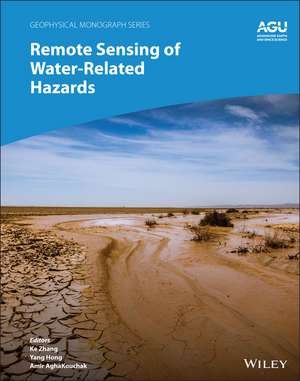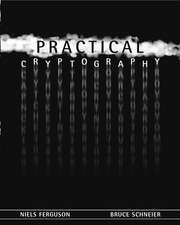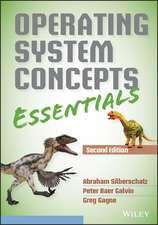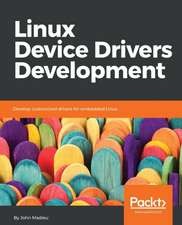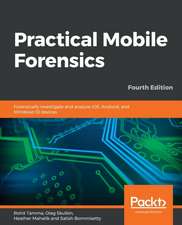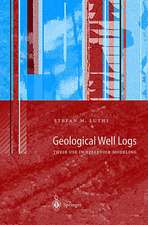Remote Sensing of Water–Related Hazards: Geophysical Monograph Series
Autor K Zhangen Limba Engleză Hardback – 31 mar 2022
The overall objectives of this proposed book is to review and summarize the recent progresses in the monitoring, modeling and early warning of natural hazards, including floods, landslides, droughts, hurricanes, wildfires, earthquakes, tornadoes and volcanoes, and collect novel techniques and discover potential applications.
The first section of the book will thus cover the methods and techniques used to monitor, detect and measure the natural hazard events and the means to obtain important informant and data to study nature hazards. The second section will describe the uses of remote sensing technologies to investigate the processes and causes of natural hazards and recent advances in the theories and mechanisms of natural hazards. Last, the third section will introduce the existing operational, early warning and forecasting systems for natural hazards.
This proposed book will include four sections: section one describes the methodologies used to monitor and detect the occurrences of natural hazards; section two summarizes the application of remote sensing technologies in investigating and understanding natural hazards; and section three provides an overview of the existing early warning and forecasting systems for natural hazards. In section one, we will present recent studies and advances that are focused on how to obtain important and necessary data to conduct the studies of natural hazards. In section two, we will compile recent advances in the theories and mechanisms that govern the processes and occurrences of natural hazards. In section three, the topic is shifted to the operational, early warning and forecasting systems for natural hazards.
Din seria Geophysical Monograph Series
- 24%
 Preț: 980.28 lei
Preț: 980.28 lei - 23%
 Preț: 1268.61 lei
Preț: 1268.61 lei - 24%
 Preț: 1015.51 lei
Preț: 1015.51 lei - 23%
 Preț: 990.95 lei
Preț: 990.95 lei -
 Preț: 810.38 lei
Preț: 810.38 lei - 24%
 Preț: 767.93 lei
Preț: 767.93 lei - 24%
 Preț: 545.80 lei
Preț: 545.80 lei - 24%
 Preț: 1178.44 lei
Preț: 1178.44 lei - 5%
 Preț: 1353.09 lei
Preț: 1353.09 lei - 8%
 Preț: 590.90 lei
Preț: 590.90 lei - 9%
 Preț: 1516.54 lei
Preț: 1516.54 lei - 9%
 Preț: 1174.90 lei
Preț: 1174.90 lei - 9%
 Preț: 1214.20 lei
Preț: 1214.20 lei - 8%
 Preț: 575.98 lei
Preț: 575.98 lei - 8%
 Preț: 443.65 lei
Preț: 443.65 lei - 9%
 Preț: 977.08 lei
Preț: 977.08 lei - 9%
 Preț: 1123.53 lei
Preț: 1123.53 lei - 9%
 Preț: 1227.86 lei
Preț: 1227.86 lei - 8%
 Preț: 544.40 lei
Preț: 544.40 lei - 9%
 Preț: 1204.23 lei
Preț: 1204.23 lei - 9%
 Preț: 1036.89 lei
Preț: 1036.89 lei - 9%
 Preț: 871.06 lei
Preț: 871.06 lei - 9%
 Preț: 1182.51 lei
Preț: 1182.51 lei - 9%
 Preț: 1166.75 lei
Preț: 1166.75 lei - 9%
 Preț: 1163.24 lei
Preț: 1163.24 lei - 9%
 Preț: 1164.08 lei
Preț: 1164.08 lei - 9%
 Preț: 1143.91 lei
Preț: 1143.91 lei - 9%
 Preț: 1205.27 lei
Preț: 1205.27 lei - 9%
 Preț: 1201.61 lei
Preț: 1201.61 lei - 9%
 Preț: 1163.60 lei
Preț: 1163.60 lei - 9%
 Preț: 1482.06 lei
Preț: 1482.06 lei - 9%
 Preț: 1307.55 lei
Preț: 1307.55 lei - 9%
 Preț: 1170.23 lei
Preț: 1170.23 lei - 9%
 Preț: 1260.46 lei
Preț: 1260.46 lei - 9%
 Preț: 1031.66 lei
Preț: 1031.66 lei - 9%
 Preț: 1205.07 lei
Preț: 1205.07 lei - 9%
 Preț: 1212.95 lei
Preț: 1212.95 lei - 8%
 Preț: 474.65 lei
Preț: 474.65 lei - 28%
 Preț: 462.57 lei
Preț: 462.57 lei - 29%
 Preț: 666.13 lei
Preț: 666.13 lei - 29%
 Preț: 763.69 lei
Preț: 763.69 lei - 26%
 Preț: 492.83 lei
Preț: 492.83 lei - 29%
 Preț: 727.08 lei
Preț: 727.08 lei - 27%
 Preț: 360.14 lei
Preț: 360.14 lei - 29%
 Preț: 514.61 lei
Preț: 514.61 lei - 28%
 Preț: 478.38 lei
Preț: 478.38 lei - 29%
 Preț: 741.99 lei
Preț: 741.99 lei - 29%
 Preț: 498.35 lei
Preț: 498.35 lei - 27%
 Preț: 510.03 lei
Preț: 510.03 lei
Preț: 1007.45 lei
Preț vechi: 1325.59 lei
-24% Nou
Puncte Express: 1511
Preț estimativ în valută:
192.78€ • 206.14$ • 160.73£
192.78€ • 206.14$ • 160.73£
Carte disponibilă
Livrare economică 28 martie-11 aprilie
Livrare express 13-19 martie pentru 44.26 lei
Preluare comenzi: 021 569.72.76
Specificații
ISBN-13: 9781119159124
ISBN-10: 1119159121
Pagini: 272
Dimensiuni: 222 x 286 x 20 mm
Greutate: 0.91 kg
Editura: Wiley
Seria Geophysical Monograph Series
Locul publicării:Hoboken, United States
ISBN-10: 1119159121
Pagini: 272
Dimensiuni: 222 x 286 x 20 mm
Greutate: 0.91 kg
Editura: Wiley
Seria Geophysical Monograph Series
Locul publicării:Hoboken, United States
Public țintă
Primary and secondary audiences and estimated total number of individualsThe primary audience for this book will be geoscientists from academic and research institutions and government agencies with strong interests in monitoring, prediction, mitigation, and management of natural hazards. Due to its interdisciplinary and multidisciplinary nature, it will be relevant to a broad range of audience in Earth Sciences: geologists, hydrologists, geophysicists, engineers, and environmental scientists. This book will also be attractive to engieers and geophysicists working in the natural hazards prevention and prediction industry, to environmental consultants and to policy makers at governmental and intergovernmental organizations. We also believe that this book can also become a textbook for graduate students and a reference book for professional–level scientists. The target audience is therefore broad and this book could potentially reach several thousands of individuals.
Which AGU Sections would find this book most relevant?
Natural Hazards Focus Group, Hydrology, Earth and Planetary Surfaces Processes, Volcanology, geochemistry and Petrology, Biogeosciences
Relevant professional organizations and, if any, annual meetings
AGU, EGU, IEEE, ASCE, AMS
Cuprins
Preface
Section 1. Monitoring and Detection of Natural Hazards
1. Virtual California: Earthquake statistics, surface deformation patterns, surface gravity changes and InSAR interferograms for arbitrary fault geometrics
Kasey Schultz et al. (University of California Davis)
2. Monitoring Fast–Moving Landslide in the Three Gorges Area By Offset Tracking Method with High–Resolution SAR Data
Mingsheng Liao et al. (Wuhan University, China)
3. A new method for detecting and monitoring atmospheric natural hazards with GPS RO
Riccardo Biondi et al. (University of Graz, Autria)
4. Integration between Satellite and Ground–Based Data for the Improvement of Volcanic Ash Retrievals and Eruption Characterization
Stefano Corradini et al. (INGV National Institute of Geophysics and Volcanology, Italy)
5. Detection of eruption–related microwave signals using a satellite–borne microwave radiometer AMSR2
Takashi Maeda (Japan Aerospace Exploration Agency)
6. Oil Spill Detection and Tracking Using Lipschitz Regularity and Multiscale Techniques in Synthetic Aperture Radar Imagery
Olaniyi Ajadi and Franz Meyer (University of Alaska Fairbanks)
7. Monitoring of precursor landslide surface deformation using InSAR image in Kuchi–Sakamoto, Shizuoka Prefecture
Hiroshi P Sato et al. (Nihon University, Tokyo, Japan)
8. A Landslide Monitoring Network based on Multi–source Spatial Sensors in Li County, Sichuan Province, China
Ping Lu et al. (Tongji University, Shanghai, China)
9. Robust Sparse Sensing Using Weather Radar
Kumar Vijay Mishra et al. (University of Iowa)
10. Detection of eruption–related microwave signals using a satellite–borne microwave radiometer AMSR2
11. Analysis of Potential Deep–Seated Landslide in Hekeng Watershed by Environment Indices
Section 2. Application of Remote Sensing in Investigating Natural Hazards
12. Using infrared remote sensing to determine volcanic ash particle size distribution and its implications
Luke Western et al. (University of Bristol, United Kingdom)
13. Landslide Investigations at Salmon Falls Creek Canyon in Idaho Using Satellite–Based Multitemporal Interferometric Synthetic Aperture Radar Techniques
Marius Necsoiu et al. (Southwest Research Institute, USA)
14. Using Seismological and electromagnetic method to study the Xishancun Landslide
RiSheng Chu et al. (Institute of Geodesy and Geophysics, China)
15. An investigation of pre–eruptive deformation for the 2004 eruption of Mount St. Helens using persistent scatterer interferometry
Mar Welch and David Schmidt (University of Washing)
16. Optical and Radar Satellite Remote Sensing for Large Area Analysis of Landslide Activity in Southern Kyrgyzstan, Central Asia
Sigrid Roessner et al. (Helmholtz Centre Potsdam GFZ German Research Centre for Geosciences)
17. Using Unmanned Aerial Vehicle (UAV) Imagery to Investigate Surface Displacements and Surface Features of the Super–Sauze Earthflow
Samuel Tizzard et al. (University of Lancaster)
18. Revised and Improved Fault Maps of Washoe County, Nevada using Light Detecting and Ranging (LiDAR) Imagery
Courtney Brailo et al. (University of Nevada Reno)
19. Using Unmanned Aerial Vehicle (UAV) Imagery to Investigate Surface Displacements and Surface Features of the Super–Sauze Earthflow
Samuel Tizzard et al. (University of Lancaster)
20. Using Advanced Remote Sensing Data Fusion Techniques for Studying Earth Surface Processes and Hazards: A Landslide Detection Case Study
21. GPS and Satellite InSAR Observations of Landslide Activity at the Sinking Canyon in South Central Idaho
Mohamed H Aly et al. (University of Arkansas)
Section 3. Early Warning Systems and Forecasting for Natural Hazards
22. An Ensembel–based Remote–Sensing Driven Flash Flood–Landslide Early Warning System
Ke Zhang et al. (University of Oklahoma)
23. Application of remotely sensed data for landslide hazard assessment and forecasting
Dalla Bach Kirschbaum et al. (NASA Goddard Space Flight Center)
24. Forecasting Rainfall Induced Landslide using High Resolution DEM and Simple Water Budget Model
Paul Kenneth et al. (University of the Philippines, Quezon City, Philippines)
25. Storm–triggerred debris avalanches in the Appalachians and possible trends in a future warming climate
Diandong Ren et al. (Curtin University, Australia)
26. Probability hazard map for future vent opening at Etna volcano (Sicily, Italy).
Placido Montalto et al. (National Institute of Geophysics and Volcanology, Italy)
Section 1. Monitoring and Detection of Natural Hazards
1. Virtual California: Earthquake statistics, surface deformation patterns, surface gravity changes and InSAR interferograms for arbitrary fault geometrics
Kasey Schultz et al. (University of California Davis)
2. Monitoring Fast–Moving Landslide in the Three Gorges Area By Offset Tracking Method with High–Resolution SAR Data
Mingsheng Liao et al. (Wuhan University, China)
3. A new method for detecting and monitoring atmospheric natural hazards with GPS RO
Riccardo Biondi et al. (University of Graz, Autria)
4. Integration between Satellite and Ground–Based Data for the Improvement of Volcanic Ash Retrievals and Eruption Characterization
Stefano Corradini et al. (INGV National Institute of Geophysics and Volcanology, Italy)
5. Detection of eruption–related microwave signals using a satellite–borne microwave radiometer AMSR2
Takashi Maeda (Japan Aerospace Exploration Agency)
6. Oil Spill Detection and Tracking Using Lipschitz Regularity and Multiscale Techniques in Synthetic Aperture Radar Imagery
Olaniyi Ajadi and Franz Meyer (University of Alaska Fairbanks)
7. Monitoring of precursor landslide surface deformation using InSAR image in Kuchi–Sakamoto, Shizuoka Prefecture
Hiroshi P Sato et al. (Nihon University, Tokyo, Japan)
8. A Landslide Monitoring Network based on Multi–source Spatial Sensors in Li County, Sichuan Province, China
Ping Lu et al. (Tongji University, Shanghai, China)
9. Robust Sparse Sensing Using Weather Radar
Kumar Vijay Mishra et al. (University of Iowa)
10. Detection of eruption–related microwave signals using a satellite–borne microwave radiometer AMSR2
11. Analysis of Potential Deep–Seated Landslide in Hekeng Watershed by Environment Indices
Section 2. Application of Remote Sensing in Investigating Natural Hazards
12. Using infrared remote sensing to determine volcanic ash particle size distribution and its implications
Luke Western et al. (University of Bristol, United Kingdom)
13. Landslide Investigations at Salmon Falls Creek Canyon in Idaho Using Satellite–Based Multitemporal Interferometric Synthetic Aperture Radar Techniques
Marius Necsoiu et al. (Southwest Research Institute, USA)
14. Using Seismological and electromagnetic method to study the Xishancun Landslide
RiSheng Chu et al. (Institute of Geodesy and Geophysics, China)
15. An investigation of pre–eruptive deformation for the 2004 eruption of Mount St. Helens using persistent scatterer interferometry
Mar Welch and David Schmidt (University of Washing)
16. Optical and Radar Satellite Remote Sensing for Large Area Analysis of Landslide Activity in Southern Kyrgyzstan, Central Asia
Sigrid Roessner et al. (Helmholtz Centre Potsdam GFZ German Research Centre for Geosciences)
17. Using Unmanned Aerial Vehicle (UAV) Imagery to Investigate Surface Displacements and Surface Features of the Super–Sauze Earthflow
Samuel Tizzard et al. (University of Lancaster)
18. Revised and Improved Fault Maps of Washoe County, Nevada using Light Detecting and Ranging (LiDAR) Imagery
Courtney Brailo et al. (University of Nevada Reno)
19. Using Unmanned Aerial Vehicle (UAV) Imagery to Investigate Surface Displacements and Surface Features of the Super–Sauze Earthflow
Samuel Tizzard et al. (University of Lancaster)
20. Using Advanced Remote Sensing Data Fusion Techniques for Studying Earth Surface Processes and Hazards: A Landslide Detection Case Study
21. GPS and Satellite InSAR Observations of Landslide Activity at the Sinking Canyon in South Central Idaho
Mohamed H Aly et al. (University of Arkansas)
Section 3. Early Warning Systems and Forecasting for Natural Hazards
22. An Ensembel–based Remote–Sensing Driven Flash Flood–Landslide Early Warning System
Ke Zhang et al. (University of Oklahoma)
23. Application of remotely sensed data for landslide hazard assessment and forecasting
Dalla Bach Kirschbaum et al. (NASA Goddard Space Flight Center)
24. Forecasting Rainfall Induced Landslide using High Resolution DEM and Simple Water Budget Model
Paul Kenneth et al. (University of the Philippines, Quezon City, Philippines)
25. Storm–triggerred debris avalanches in the Appalachians and possible trends in a future warming climate
Diandong Ren et al. (Curtin University, Australia)
26. Probability hazard map for future vent opening at Etna volcano (Sicily, Italy).
Placido Montalto et al. (National Institute of Geophysics and Volcanology, Italy)
Notă biografică
Ke Zhang, Hohai University, China. Yang Hong, University of Oklahoma, USA. Amir AghaKouchak, University of California, Irvine, USA.
